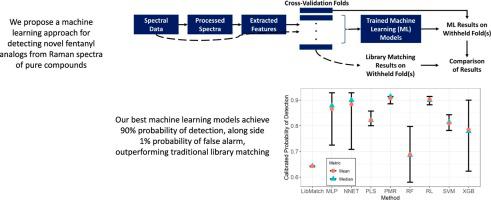Forensic Chemistry ( IF 2.7 ) Pub Date : 2023-05-26 , DOI: 10.1016/j.forc.2023.100506 Phillip Koshute , N. Jordan Jameson , Nathan Hagan , David Lawrence , Adam Lanzarotta

|
In previous research, we demonstrated the promise of detecting novel fentanyl analogs from mass spectra using machine learning models. This approach complements existing library matching methods and provides a key capability amid the recent sharp increase in abuse of fentanyl and its analogs. However, many applications rely upon portable devices such as Raman spectrometers, rather than mass spectrometers that are generally located in laboratories. In response, we adapted our models to Raman-based sensing, devising a machine learning approach for detecting novel fentanyl analogs from Raman spectra. Whereas mass spectra consist of well-defined discrete peaks, Raman spectra are continuous. To aid model development, we extracted features from each spectrum using smoothing, background subtraction, and principal component analysis (PCA). Additionally, we extracted features related to spectral peaks and similarity to spectra of known compounds; these features were guided by subject-matter expertise. We also used a third feature set that combined the features from PCA and from spectral peaks. With these three feature sets as inputs, we developed fentanyl analog classification models using various machine learning techniques. These techniques included multi-layer perceptron, neural network, partial least squares, penalized multinomial regression, random forest, regularized logistic regression, support vector machines, and extreme gradient boosting. We developed and tested our models using 320 Raman spectra of pure compounds, assessing performance via cross-validation. Models with PCA-based features performed better than those using expert-based features, achieving more than 90% probability of detection alongside less than 1% probability of false alarm. Although fentanyl compounds are often found with other components (e.g., cutting agents), some applications such as mail screening may encounter relatively pure fentanyl analogs. The results within this study suggest that our machine learning models are particularly promising for such applications.
中文翻译:

从纯化合物的拉曼光谱中分类新型芬太尼类似物的机器学习方法
在之前的研究中,我们展示了使用机器学习模型从质谱中检测新型芬太尼类似物的前景。这种方法补充了现有的库匹配方法,并在最近芬太尼及其类似物滥用急剧增加的情况下提供了关键功能。然而,许多应用依赖于拉曼光谱仪等便携式设备,而不是通常位于实验室的质谱仪。作为回应,我们将我们的模型调整为基于拉曼的传感,设计了一种机器学习方法来检测拉曼光谱中的新型芬太尼类似物。质谱由明确定义的离散峰组成,而拉曼光谱是连续的。为了帮助模型开发,我们使用平滑、背景减除和主成分分析 (PCA) 从每个光谱中提取特征。此外,我们提取了与光谱峰相关的特征以及与已知化合物光谱的相似性;这些功能以主题专业知识为指导。我们还使用了第三个特征集,它结合了 PCA 和光谱峰的特征。以这三个特征集作为输入,我们使用各种机器学习技术开发了芬太尼模拟分类模型。这些技术包括多层感知器、神经网络、偏最小二乘法、惩罚多项式回归、随机森林、正则化逻辑回归、支持向量机和极端梯度提升。我们使用纯化合物的 320 个拉曼光谱开发和测试了我们的模型,并通过交叉验证评估了性能。具有基于 PCA 特征的模型比使用基于专家特征的模型表现更好,实现超过 90% 的检测概率和低于 1% 的误报概率。尽管芬太尼化合物经常与其他成分(例如,切割剂)一起被发现,但邮件筛选等一些应用可能会遇到相对纯的芬太尼类似物。这项研究的结果表明,我们的机器学习模型对于此类应用特别有前途。



























 京公网安备 11010802027423号
京公网安备 11010802027423号